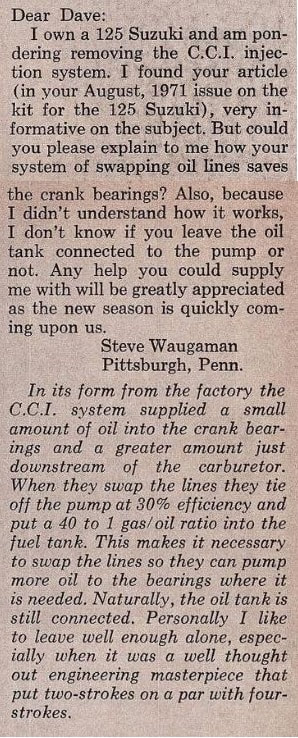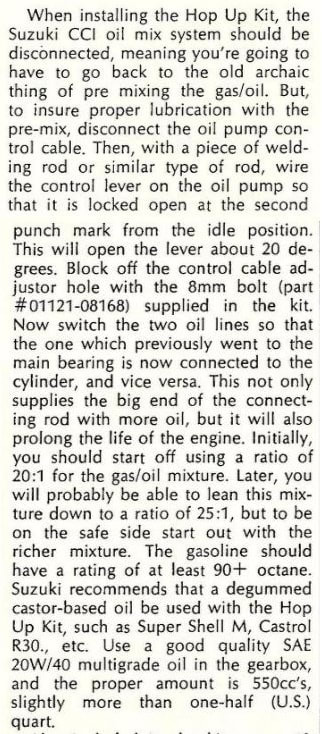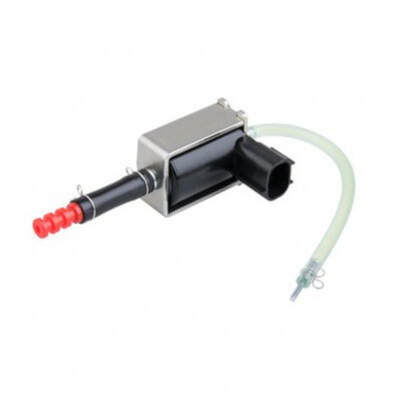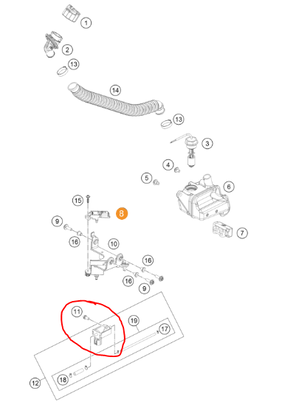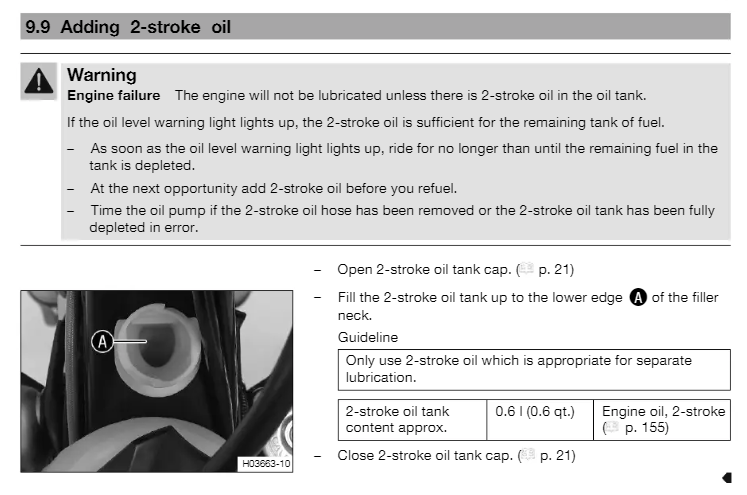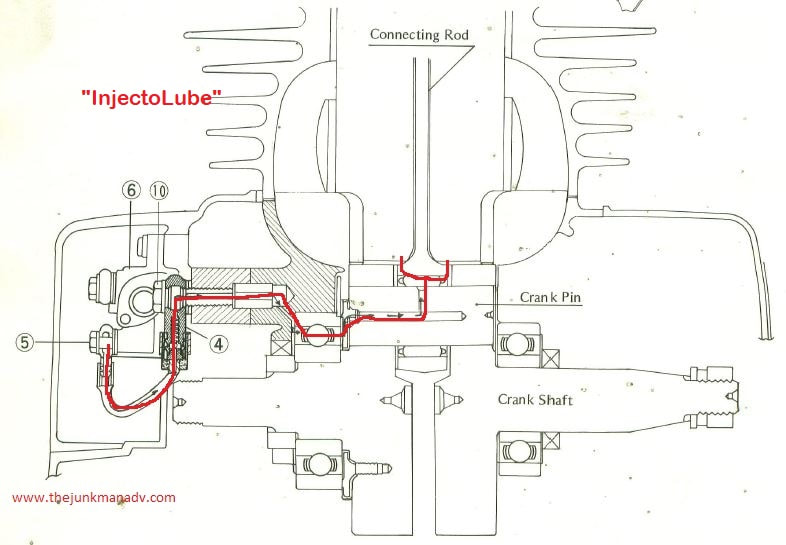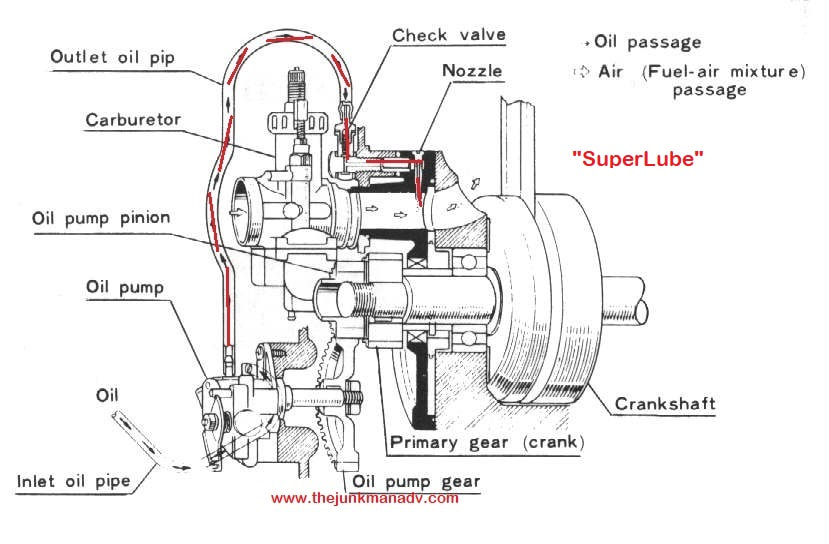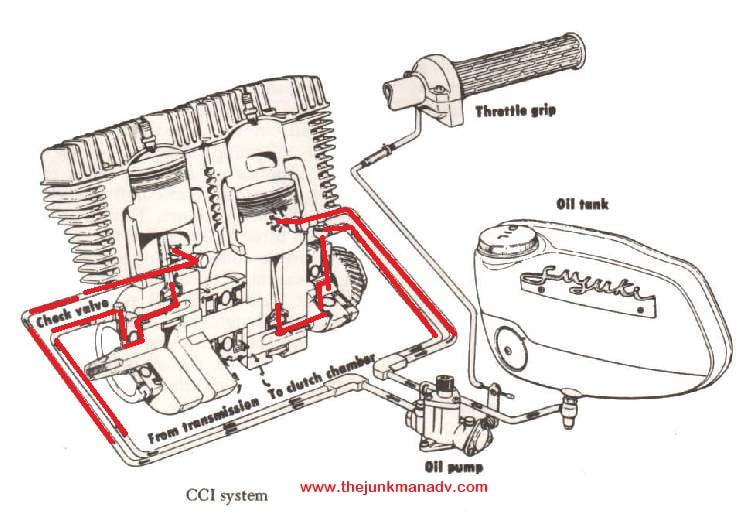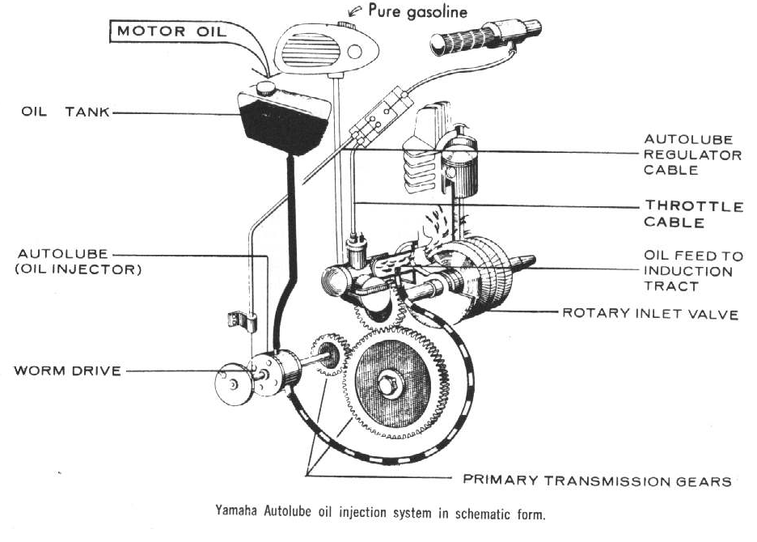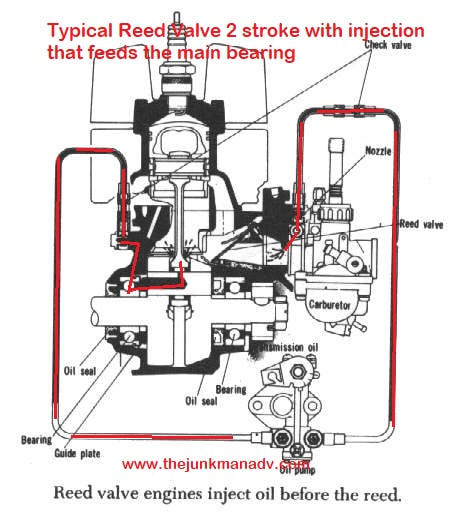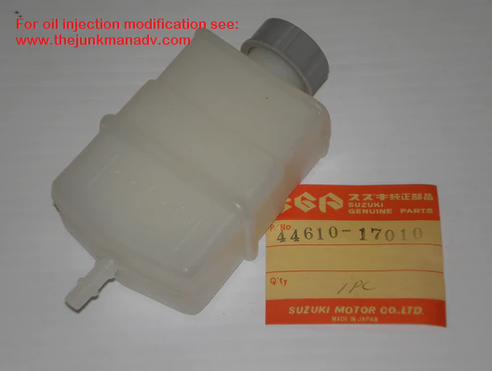2 stroke oil injection, why the hate?
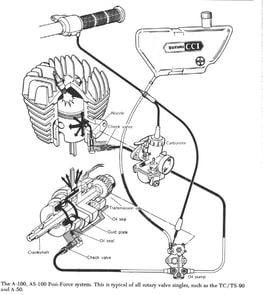 Suzuki CCI oil injection system that cannot be disabled (see reference at bottom of page)
Suzuki CCI oil injection system that cannot be disabled (see reference at bottom of page)
Back in the day (60's and 70's) when the Japanese started taking over the motorcycle market in a big way in the US, most of the small inexpensive, reliable, street legal bikes were 2 strokes. Most came with oil injection, it worked, so why the hate now?
(2023 context update)
Since this article was originally written. 2 stroke oil injection on motocross/enduro/offroad has made as small comeback with the advent of electronic direct and throttle body fuel injection (EFI) systems fitted on 2 stroke engine models. Most notably on certain KTM, Husqvarna, and GasGas motorcycles. I feel a revival of interest and questioning of the oil injection system removal will be debated in forums, groups and comment sections. A lot of this information will still hold for these modern systems as fundamentally the rational and inclusion of an oil injection system has not changed from the first oil injection system ever fitted to a 2 stroke motorcycle, the 1964 Yamaha YA-6 125cc *Santa-Barbara*.
For explanations of specific manufacturers oil injection systems and modifications, see bottom of page.
For those maybe unfamiliar with engine designs and technology you can Google how a two stroke engine works. A 4 stroke engine also has camshafts, intake and exhaust valves, as well as some other complex things that are not important to this discussion so I will forgo their mention.
Anyways the stark difference in the oiling system is that with this total loss oiling is that the lubrication (oil) needs to be introduced directly into the cylinder and or the crankcase, and in some cases main bearings, during operation for lubrication and cooling. I should also note that 2 stroke engines have a separated transmission oil cavity.
The most basic way to achieve proper lubrication is to mix a little bit of oil in with the fuel, this is called premix. Premix ratios (eg. 40:1) vary by the requirements of the engine for proper lubrication. This method is fine for stationary engines, OPE (outdoor power equipment), and power sports engines, including watercraft, designed around closed course racing or riding within a short distance of the gas can you have your premix stored in. Because the fact that you must mix the oil and fuel together in a precise ratio (so much oil per gallon of fuel) it makes it very inconvenient for street ridden motorcycles where fueling up at a gas station as a measuring device and oil would need to be carried by the rider and some math would need to be done at every fill up.
Enter the advent of the 2 stroke oil injection system. An invention to make this whole process of mixing the oil with the fuel automatic so one can just fill up with straight fuel at the pump and be on his/her way, with one caveat, keeping the oil tank full. For reference a typical oil tank on these bikes holds a little over a quart of 2 stroke specific oil which generally yields over 500 miles of riding. And there in lies a potential problem, more on this later. With this invention it allowed cheap and powerful engines to be fitted into street and enduro (dual sport) motorcycles that were easy for the average or beginning motorcyclist to operate, just gas and go, just like a (heavier, lower power per cc, more expensive) 4 stroke motorcycle of the time.
Now fast forward 30-40 years and since 1985 new street legal 2 stroke motorcycles are banned in the US from importation (still available for importation as off road only and street legal under 50cc) people buy these old motorcycles and fix them up to ride and don't necessarily understand the intricacies of the oiling system. Now it always happens, across forums dedicated to motorcycling/boating for the particular bike/boat that has these systems, someone posts questions about; whether or not to remove the oil injection system on their XXXX <--- insert brand and model here. And of course people respond both in favor of keeping it and removing it, however the majority seems to lean towards removal with the reasoning that "its unreliable" but not really giving any other evidence to support why it is unreliable, and thus the hate on the oil injection system.
(2023 context update)
Since this article was originally written. 2 stroke oil injection on motocross/enduro/offroad has made as small comeback with the advent of electronic direct and throttle body fuel injection (EFI) systems fitted on 2 stroke engine models. Most notably on certain KTM, Husqvarna, and GasGas motorcycles. I feel a revival of interest and questioning of the oil injection system removal will be debated in forums, groups and comment sections. A lot of this information will still hold for these modern systems as fundamentally the rational and inclusion of an oil injection system has not changed from the first oil injection system ever fitted to a 2 stroke motorcycle, the 1964 Yamaha YA-6 125cc *Santa-Barbara*.
For explanations of specific manufacturers oil injection systems and modifications, see bottom of page.
For those maybe unfamiliar with engine designs and technology you can Google how a two stroke engine works. A 4 stroke engine also has camshafts, intake and exhaust valves, as well as some other complex things that are not important to this discussion so I will forgo their mention.
Anyways the stark difference in the oiling system is that with this total loss oiling is that the lubrication (oil) needs to be introduced directly into the cylinder and or the crankcase, and in some cases main bearings, during operation for lubrication and cooling. I should also note that 2 stroke engines have a separated transmission oil cavity.
The most basic way to achieve proper lubrication is to mix a little bit of oil in with the fuel, this is called premix. Premix ratios (eg. 40:1) vary by the requirements of the engine for proper lubrication. This method is fine for stationary engines, OPE (outdoor power equipment), and power sports engines, including watercraft, designed around closed course racing or riding within a short distance of the gas can you have your premix stored in. Because the fact that you must mix the oil and fuel together in a precise ratio (so much oil per gallon of fuel) it makes it very inconvenient for street ridden motorcycles where fueling up at a gas station as a measuring device and oil would need to be carried by the rider and some math would need to be done at every fill up.
Enter the advent of the 2 stroke oil injection system. An invention to make this whole process of mixing the oil with the fuel automatic so one can just fill up with straight fuel at the pump and be on his/her way, with one caveat, keeping the oil tank full. For reference a typical oil tank on these bikes holds a little over a quart of 2 stroke specific oil which generally yields over 500 miles of riding. And there in lies a potential problem, more on this later. With this invention it allowed cheap and powerful engines to be fitted into street and enduro (dual sport) motorcycles that were easy for the average or beginning motorcyclist to operate, just gas and go, just like a (heavier, lower power per cc, more expensive) 4 stroke motorcycle of the time.
Now fast forward 30-40 years and since 1985 new street legal 2 stroke motorcycles are banned in the US from importation (still available for importation as off road only and street legal under 50cc) people buy these old motorcycles and fix them up to ride and don't necessarily understand the intricacies of the oiling system. Now it always happens, across forums dedicated to motorcycling/boating for the particular bike/boat that has these systems, someone posts questions about; whether or not to remove the oil injection system on their XXXX <--- insert brand and model here. And of course people respond both in favor of keeping it and removing it, however the majority seems to lean towards removal with the reasoning that "its unreliable" but not really giving any other evidence to support why it is unreliable, and thus the hate on the oil injection system.
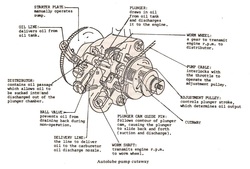 Close up of a typical oil injection pump
Close up of a typical oil injection pump
(Warning opinion ahead!) I would like to weigh in why I think the majority of people believe it is unreliable and seem to recommend removing it and switching to premix. My though is that the unreliability is not with the system itself, it lies with the owner/operator that didn't quite understand how the system was supposed to work and it's requirements to function properly, thus their opinion is "the system is just unreliable", it could not have been any of their shortcomings that caused it to fail!.
Here is my top 4 reasons why I think oil injection gets a bad rap all these years later.
All of these can lead to piston seizes or engine damage.
1.) Early 2 stroke oil was under developed and not specifically designed around injection systems, until later years. New oils are far superior, even cheapo store brands are better than the oils of the old days. There are also premix only oils (generally thicker) that get incorrectly used in injection systems.
2.) Confusion by new buyers or 1st time motorcycle riders, of what oil to use. Depending on the year or bike some owners manuals either were not clear or specified things like 20W, 30W motor oil as suitable. This was at a time when straight weight motor oils for cars were even of questionable performance and quality. This might lead to god knows what type of oils could have been run through the system.
3.) The unfamiliarity with the stark differences between what a 2 stroke and 4 stroke engine is by new rider. A lot of early 2 stroke street bikes of the late 50's and mid 60's were pre-mix only.
The injection system was a way to try and take the guess work out of operation of a 2 stroke street legal motorcycle for everyday use. Just gas and go, and every 500 miles or so top up the oil tank. That "top up the oil tank" could be easily forgotten as this is something that didn't have to be done when driving a car or 4 stroke motorcycle. Think about it, some of these "new" riders buying larger Japanese enduros and street bikes might have came off of the Honda step through CT90 (a 4 stroke motorcycle) through the You meet the nicest people on a Honda campaign. Not fully understanding some extra needs these alternative 2 stroke bikes need in everyday use.
4.) Running the tank empty and filling it up and not priming or bleeding the system. Most of these systems do not self prime very well and it would be easy to take off and ride 50 miles or more before the system is fully primed and free of any air bubbles in the line, thus some of that run time is with only intermittent oil flow through the injection system.
Any one of the above could cause engine damage and thus would be blamed on the injection pump. I think the misunderstanding of the root cause of the lubrication problem to the engine has caused the perpetuation of the idea that "It is just bad, it causes piston seizures, remove it and switch to premix, at least you know the engine is getting lubrication then." However some motorcycle engine designs (certain makes and models) make it a bit more difficult to just unhook it and run premix because the injection also provides pressurized lubrication for the crankshaft main bearings that would not normally come from the intake air/fuel charge, SEE BELOW. Now I am not going to sit here and say that the systems don't have failure points, but I think it is more likely a rider will incorrectly mix the wrong ratio of premix (or worse forget to mix) than experience a major system failure.
So my opinion is if the old bike you just bought still has all the oil injection parts intact, adjust it, prime it, use it. Many people logged thousands of miles on bikes with 2 stroke oil injection and with other proper maintenance have experienced similar longevity to a 4 stroke engine.
Those people (including me) just might have a few oil stain specks on the back of their jacket though. Leave a comment if you like!
Here is my top 4 reasons why I think oil injection gets a bad rap all these years later.
All of these can lead to piston seizes or engine damage.
1.) Early 2 stroke oil was under developed and not specifically designed around injection systems, until later years. New oils are far superior, even cheapo store brands are better than the oils of the old days. There are also premix only oils (generally thicker) that get incorrectly used in injection systems.
2.) Confusion by new buyers or 1st time motorcycle riders, of what oil to use. Depending on the year or bike some owners manuals either were not clear or specified things like 20W, 30W motor oil as suitable. This was at a time when straight weight motor oils for cars were even of questionable performance and quality. This might lead to god knows what type of oils could have been run through the system.
3.) The unfamiliarity with the stark differences between what a 2 stroke and 4 stroke engine is by new rider. A lot of early 2 stroke street bikes of the late 50's and mid 60's were pre-mix only.
The injection system was a way to try and take the guess work out of operation of a 2 stroke street legal motorcycle for everyday use. Just gas and go, and every 500 miles or so top up the oil tank. That "top up the oil tank" could be easily forgotten as this is something that didn't have to be done when driving a car or 4 stroke motorcycle. Think about it, some of these "new" riders buying larger Japanese enduros and street bikes might have came off of the Honda step through CT90 (a 4 stroke motorcycle) through the You meet the nicest people on a Honda campaign. Not fully understanding some extra needs these alternative 2 stroke bikes need in everyday use.
4.) Running the tank empty and filling it up and not priming or bleeding the system. Most of these systems do not self prime very well and it would be easy to take off and ride 50 miles or more before the system is fully primed and free of any air bubbles in the line, thus some of that run time is with only intermittent oil flow through the injection system.
Any one of the above could cause engine damage and thus would be blamed on the injection pump. I think the misunderstanding of the root cause of the lubrication problem to the engine has caused the perpetuation of the idea that "It is just bad, it causes piston seizures, remove it and switch to premix, at least you know the engine is getting lubrication then." However some motorcycle engine designs (certain makes and models) make it a bit more difficult to just unhook it and run premix because the injection also provides pressurized lubrication for the crankshaft main bearings that would not normally come from the intake air/fuel charge, SEE BELOW. Now I am not going to sit here and say that the systems don't have failure points, but I think it is more likely a rider will incorrectly mix the wrong ratio of premix (or worse forget to mix) than experience a major system failure.
So my opinion is if the old bike you just bought still has all the oil injection parts intact, adjust it, prime it, use it. Many people logged thousands of miles on bikes with 2 stroke oil injection and with other proper maintenance have experienced similar longevity to a 4 stroke engine.
Those people (including me) just might have a few oil stain specks on the back of their jacket though. Leave a comment if you like!
Supporting evidence from period sources that warn against modification
Here is two excerpts from Modern Cycle Magazine (8-1972 & 6-1971). The first is a question to "Dear Dave" from "Steve Waugaman" from Pittsburg PA (Modern Cycle August 1972) asking about removing or modifying the oil injection from his Suzuki with CCI (Suzuki's injection system), presumably a TS125 but he didn't specify. An excerpt of the article (Modern Cycle June 1971) that the that "Steve" is referencing listed here as well. Read the response for yourself.
I believe that this article below supports my assertion that the systems are reliable and increase reliability of 2 strokes that came equipped. Also Suzuki's CCI is one that directly feeds the main bearings so elimination is detrimental to engine longevity.
I believe that this article below supports my assertion that the systems are reliable and increase reliability of 2 strokes that came equipped. Also Suzuki's CCI is one that directly feeds the main bearings so elimination is detrimental to engine longevity.
Modern 2 stroke oil injection systems
as found on some KTM, Husqvarna, GasGas models
as found on some KTM, Husqvarna, GasGas models
Below is an example of a 2 stroke oil injection system that is found on some 2018 and newer KTM, Husqvarna, and GasGas models that works in conjunction with modern 2 stroke EFI/Throttle body fuel injection systems. The main difference in operation is now the pump is electric, no longer engine driven, and the injection is controlled by the ECU for precise injection of the oil in conjunction with the fuel based on engine demands, crankcase pressure, RPM, and throttle position.
Some benefits I see, versus the purely mechanical designs of the past, are things like: more precise dosing of the oil, less oil deposit buildup, lower overall oil consumption, lower emissions/less smoke, improved lubrication, especially in downhill or long durations where the throttle is "closed". Low oil warning light should prevent users from running the tank empty and thus introducing air in the system. Which as explained previously is why I think most early injection systems got a bad rap.
The possible downsides are: The pump is electric, electrics can fail, crankcase sensor is electric, same issue. However, the ECU is possibly calibrated with some diagnostic protocol to account for these two parts failure and disable starting (as of this writing I don't know if this is true). My hypothesis is they will be reliable as the pump itself runs constantly in oil and the electric motor is indirectly cooled by this oil flow. We won't really know the reliability of these components for a very long time or when these bikes age to 30+ years. Time will tell. This is only speculation at this point.
Some benefits I see, versus the purely mechanical designs of the past, are things like: more precise dosing of the oil, less oil deposit buildup, lower overall oil consumption, lower emissions/less smoke, improved lubrication, especially in downhill or long durations where the throttle is "closed". Low oil warning light should prevent users from running the tank empty and thus introducing air in the system. Which as explained previously is why I think most early injection systems got a bad rap.
The possible downsides are: The pump is electric, electrics can fail, crankcase sensor is electric, same issue. However, the ECU is possibly calibrated with some diagnostic protocol to account for these two parts failure and disable starting (as of this writing I don't know if this is true). My hypothesis is they will be reliable as the pump itself runs constantly in oil and the electric motor is indirectly cooled by this oil flow. We won't really know the reliability of these components for a very long time or when these bikes age to 30+ years. Time will tell. This is only speculation at this point.
Explanation of Kawasaki's oil injection systems and the differences.
There are two main oil injection systems that Kawasaki used from 1967-2001 for rotary valve & piston port models. Injecto-Lube & Super-Lube. Early Kawasaki pre-1966 models were premix only. Consult the official owners manual for details on your specific model.
|
"InjectoLube" The oil path goes through both the intake and the right side main bearing and lubricates the big end rod bearing. CANNOT RUN Pre-Mix only in this type of system or bearing damage could result from lack of lubrication.
|
"SuperLube" The oil path injects only into the intake path. The bearings are then lubricated by the air/fuel mix by more conventional means. CAN RUN Pre-Mix.
|
Explanation of Suzuki's CCI oil in injection
Suzuki's CCI (also Posi-Force) oil injection is similar to Kawasaki's Injecto-Lube in that the oiling system injects oil to the main & connecting rod bearings as well as the intake tract. Bikes with these systems cannot run pre-mix for risk of bearing failure from inadequate lubrication.
Yamaha's Autolube System
Permitted oil injection modifications
Us the below information at your own risk. Improper understanding or modifications can result in engine damage.
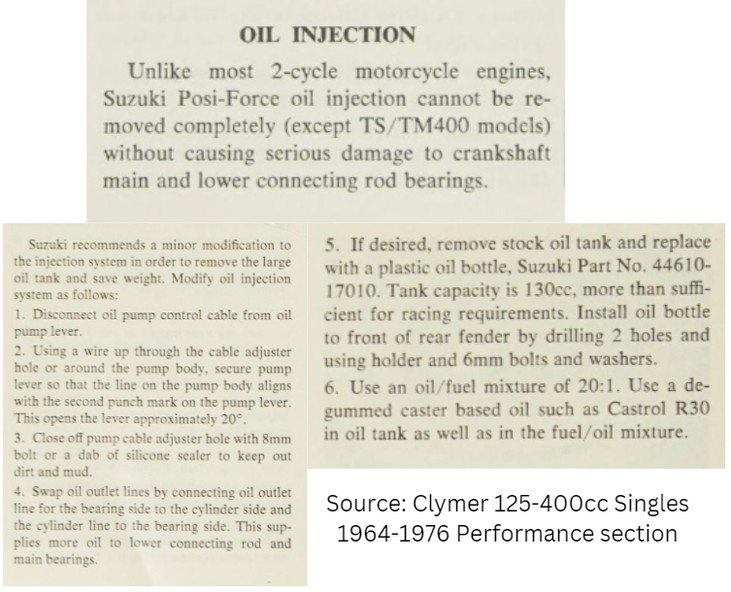 Clymer manual references the 1971 Modern Cycle article from Suzuki's own "hop up" manual
Clymer manual references the 1971 Modern Cycle article from Suzuki's own "hop up" manual
Suzuki CCI & Posi-Force Oil Injection
Minor modification steps:
Unlike most 2 stroke motorcycle engines, Suzuki Posi-Force oil injection cannot be removed completely (except TS/TM400 models) without causing serious damage to crankshaft main and lower connecting rod bearings.
Suzuki recommends a minor modification to the injection system in order to remove the large oil tank and save weight. Modify oil injection system as follows;
1. Disconnect oil pump control cable from oil pump lever.
2. Using a wire up through the cable adjuster hole or around the pump body, secure the pump lever so that the line on the pump body aligns with the second punch mark on the pump lever. This opens the lever aprox. 20 degrees.
3. Close off the pump cable adjuster hole with 8mm bolt or dab of silicone sealer to keep out dirt and mud.
4. Swap oil outlet lines by connecting oil outlet line for the bearing side to the cylinder side and the cylinder line to the bearing side. This supplies more oil to the lower connecting rod and main bearings.
5. If desired, remove stock oil tank and replace with plastic oil bottle, Suzuki Part No. 44610-17010 (see image). Tank capacity is 130cc, more than sufficient for racing requirements. Install oil bottle to front of rear fender by drilling 2 holes and using holder and 6mm bolts and washers.
6. Use an oil/fuel mixture of 20:1. Use a degummed caster based oil such as Castrol R30 in oil tank as well as in the fuel/oil mixture.
Minor modification steps:
Unlike most 2 stroke motorcycle engines, Suzuki Posi-Force oil injection cannot be removed completely (except TS/TM400 models) without causing serious damage to crankshaft main and lower connecting rod bearings.
Suzuki recommends a minor modification to the injection system in order to remove the large oil tank and save weight. Modify oil injection system as follows;
1. Disconnect oil pump control cable from oil pump lever.
2. Using a wire up through the cable adjuster hole or around the pump body, secure the pump lever so that the line on the pump body aligns with the second punch mark on the pump lever. This opens the lever aprox. 20 degrees.
3. Close off the pump cable adjuster hole with 8mm bolt or dab of silicone sealer to keep out dirt and mud.
4. Swap oil outlet lines by connecting oil outlet line for the bearing side to the cylinder side and the cylinder line to the bearing side. This supplies more oil to the lower connecting rod and main bearings.
5. If desired, remove stock oil tank and replace with plastic oil bottle, Suzuki Part No. 44610-17010 (see image). Tank capacity is 130cc, more than sufficient for racing requirements. Install oil bottle to front of rear fender by drilling 2 holes and using holder and 6mm bolts and washers.
6. Use an oil/fuel mixture of 20:1. Use a degummed caster based oil such as Castrol R30 in oil tank as well as in the fuel/oil mixture.
Kawasaki F5 & F9 Big Horn oil injection modification
As described in the "Speed Kit" manual for racing application.
Oil Pump information (verbiage from speed kit manual page 6)
"In the case of the F5 kit parts installed. The pre-mixed fuel (15:1) is used. Therefore it is not necessary to lubricate the main bearing con rod and big end. Remove the oil pump cable from the oil pump lever and set the oil pump lever to full closed position. At which flow amount of oil is 110cc / hour at 3,000 rpm."
Because of grammatical mistakes in translation some misinterpretation happens with people thinking that complete removal of the oil pump system is being recommended or is warranted. This is not the case, the manual simply is trying to state that the primary means of lubrication is now premix (in stock form straight fuel is used and the pump varies the oil output via cable attached to the throttle cable) the oil pump system is now supplementary feeding a constant (less than) 2cc of oil per minute to ensure enough lubrication gets to the right side bearing during operation because of the engine/crank design. This is backed up by the information on page 8 under OTHERS stating what parts can or should be removed for a racing application, the oil tank is not listed as parts acceptable to remove. I believe some people have experienced engine damage due to removal of the system entirely not realizing the bearings still need some supplemental lubrication even when switching to premix in this application.
As described in the "Speed Kit" manual for racing application.
Oil Pump information (verbiage from speed kit manual page 6)
"In the case of the F5 kit parts installed. The pre-mixed fuel (15:1) is used. Therefore it is not necessary to lubricate the main bearing con rod and big end. Remove the oil pump cable from the oil pump lever and set the oil pump lever to full closed position. At which flow amount of oil is 110cc / hour at 3,000 rpm."
Because of grammatical mistakes in translation some misinterpretation happens with people thinking that complete removal of the oil pump system is being recommended or is warranted. This is not the case, the manual simply is trying to state that the primary means of lubrication is now premix (in stock form straight fuel is used and the pump varies the oil output via cable attached to the throttle cable) the oil pump system is now supplementary feeding a constant (less than) 2cc of oil per minute to ensure enough lubrication gets to the right side bearing during operation because of the engine/crank design. This is backed up by the information on page 8 under OTHERS stating what parts can or should be removed for a racing application, the oil tank is not listed as parts acceptable to remove. I believe some people have experienced engine damage due to removal of the system entirely not realizing the bearings still need some supplemental lubrication even when switching to premix in this application.

